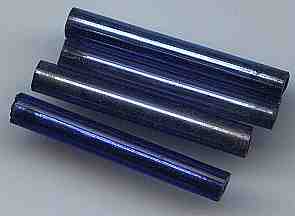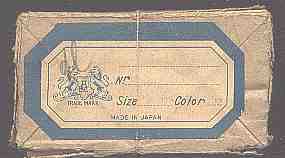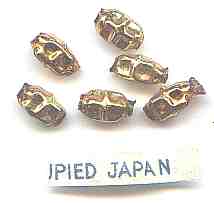The Bead Site =Home>Beadmaking and Materials>Beadmaking, Glass > East Asia
Oh, That Blue Bead!
East Asian Shared Beadmaking
Recently a visitor asked about some blue silver-lined beads.
My first response was they could have been made in many places.
However, when she sent to me a graphic, my response was "Oh, that blue bead!"
|
So, the beads are Chinese, right? It would seem so. Bolstering this is a box covered with similar beads in a brown color in the National Museum of Taiwan. It dates to the Qing (1644-1911) period, probably toward the end.
But, this is not the end of the story.
|
Another piece of evidence is found in a popular book by Klamkin (1976: # 450, 451). Three Christmas tree decorations are pictured with these beads; two have tags saying "Made in Occupied Japan."
What's going on? After the opening of Japan to the world, forced on it by the United States in 1868, Japan began an export drive that included glass beads.
|
The Japanese also began spreading their technology to neighboring countries. They built a large, modern Glass factory in the beadmaking center of Boshan, China around 1910. They operated at least five glass factories in China by the early 1920s, long before Japan invaded China.
The Japanese also introduced glass beadmaking to Korea. After invading in 1910, they took five young Korean boys to Japan in 1927 and taught them traditional beadmaking. During occupation and even long afterwards, many beads were sold to Japan, repackaged there and marked "Made in Japan."
My conclusion is that the blue beads shown above could have been made in either Japan or in China, with technical input from Japan. The ones in the "Made in Japan" package could just as easily have been made in China.
Is this cheating? Well, I suppose, but it is hardly unique in the export business.
NOTE:
1 It is impossible from the published reference to this store (Fenstermaker and Williams 1979: 51) to ascertain exactly what the name of the store was.
REFERENCES CITED:
Fenstermaker, G. B. and Alice T. Williams 1979 The Chinese Bead and the romance of the bead-jewelry trail Fenstermaker Books, Lancaster PA.
Klamkin, Marian 1976 Made in Occupied Japan:
A Collector's Guide Crown, New York
_________________________________________________
Small Bead Businesses | Beading & Beadwork | Ancient Beads | Trade Beads
Beadmaking & Materials | Bead Uses | Researching Beads | Beads and People
Center for Bead Research | Book Store | Free Store | Bead Bazaar
Shopping Mall | The Bead Auction | Galleries | People | Events
The Bead Site Home | Chat Line | Contact Us | Site Search Engine | FAQ


